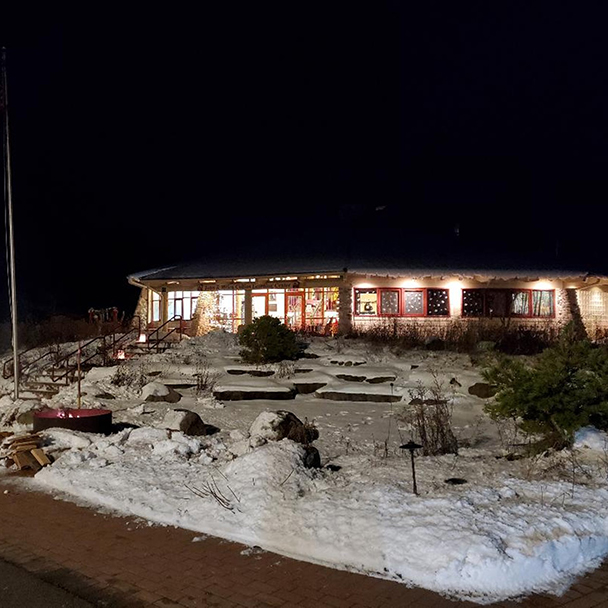By Coggin Heeringa
Interpretive Naturalist, Crossroads at Big Creek, Inc.
“There’s is no place like home for the holidays,” and for many folks who make Door County their home or who come home for the holidays, the traditions at Crossroads are a must. This Saturday, Crossroads will be a part of the Annual Christmas Bird Count. On the night of the Winter Solstice (this year, December 21), we will hold our now traditional luminary-lit hike and bonfire. New this year, if the sky is clear, the Door Peninsula Astronomical Society will offer Night Sky Viewing at the Astronomy Campus. Earlier in the week, the Junior Nature Club will be decorating the bird feeders with greens, another Crossroads’ tradition.
We need holiday cheer and traditions this dark time of year. Our fully shielded parking lot lights are set to come on at 4:30 p.m., and on cloudy days, that isn’t even early enough. Hours of daylight have certainly diminished. Depressing, but not frightening. We know that after the Winter Solstice, the days will start getting longer. Knowledge of science is a comfort.
Primitive people did not know the Earth’s axis is tilted and that seasons progress in a predictable way. Things would be going relatively well for them … food was plentiful and days were warm. But then, plants began to die, and temperatures dropped, and scariest of all, the days started to get shorter. It must have seemed to them that the world was coming to an end.
We will never know for sure, but historians speculate that because a few plants – evergreens, holly, and mistletoe – did not die in the fall, early Northern Europeans believed that these plants were magic, with power over darkness. Perhaps if they brought these magical plants into their caves and hovels, the Sun would come back.
So, at this time of year, the people cut trees and brought them inside and when they did –sure enough – slowly but surely, the days started to get longer and, each year, the world eventually became green once more.
Also, though details are lost to antiquity, around the Solstice, the prehistoric people of northern climates lit torches and bonfires and presumably danced to encourage the Sun to return to the land.
We still decorate with evergreens this time of year. And at Crossroads, we light candles and bonfires. Ancient traditions are hard to break.
The tradition of the Audubon Christmas Bird Count is only 123 years old, and Crossroads has participated in the annual event, which is organized by Charlotte Lukes, for at least twenty years. This year, December 17 is designated for the Sturgeon Bay Count.
For most participants, Christmas Count is an all-day endeavor, but we at Crossroads want to make it a bit less strenuous, so we will send “community scientists” out into the Cove Estuary and Big Creek Preserves along marked trails for an hour or so. Participants will then bring their data back to the Collins Learning Center and enjoy a cup of hot chocolate or coffee.
We will provide check lists, but we also encourage the use of eBird. eBird provides a number of helpful identification tools and all data entered into eBird becomes part of a world-wide data base, furthering what we know globally about birds. In fact, in the three days preceding the count, we will offer one-on-one, stop-in tutorials on how to load and use the free eBird app. This is a fun activity for individuals, groups and families.
In a way, birds are like the people of Door County. Some make the peninsula their year-round home. Some come back for a while this time of year.
Children often ask, “Do our winter birds build nests?” The short answer is, “No.” In fact, our year-round residents do not use nests either. Nests are nurseries—the place to lay eggs and feed infant birds. Once the fledglings are gone, nests are abandoned.
That said, birds tend to make their winter roots in the same sort of places they make their nests. So, for example, chickadees, nuthatches and woodpeckers roost in tree cavities or unused woodpecker holes.
Blue Jays, Northern Cardinals and nuthatches roost with their own kind in dense conifers, while doves look for a flat, shelf-like platform of some kind. Finches also gather in evergreens, but on really cold night, sometimes burrow in the snow.
We sincerely hope that residents and holiday visitors will leave their warm, cozy winter homes and participate outdoors by using our trails and taking part in Crossroads’ holiday traditions, all of which are free and open to residents and visitors of all ages and of all backgrounds. As for Ski-for-Free, as soon as there is enough snow to form a solid base, we will open. Watch our Facebook and/or website.



 ALL CONTENT © 2024 BY DOOR GUIDE PUBLISHING
ALL CONTENT © 2024 BY DOOR GUIDE PUBLISHING




